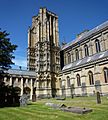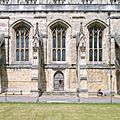William Wynford facts for kids
William Wynford (who worked from about 1360 to 1405) was one of England's most successful master builders in the 1300s. He was famous for using a new and exciting style called Perpendicular Gothic. This style made buildings look tall and grand with lots of straight lines.
Contents
Who Was William Wynford?
William Wynford first appears in records around 1360. At that time, he was working at Windsor Castle as a supervisor for the stone masons. These were the skilled workers who shaped and laid the stones for buildings.
Early Career and Important Connections
In 1365, William Wynford became the main builder, or master mason, at Wells Cathedral. Many people believe he designed the impressive South West tower there. It was probably at Wells that he met William of Wykeham. Wykeham was a very important person who later became a bishop.
Wynford's skills were noticed, and in 1364, he became the master of works at Windsor Castle, working under Wykeham. In 1372, Edward III, the king at the time, even gave Wynford a special yearly payment of £10. This was a lot of money back then!
Working for the King and Nobles
Wynford continued to be very busy. In 1375–76, he worked at Abingdon Abbey. He also worked for the king at Corfe Castle in 1377–78. There, he helped build new rooms inside the castle's main tower, called the keep. In 1378, Wynford even worked alongside another famous builder, Henry Yevele, in Southampton.
Designing Famous Colleges
When King Edward III died, the new king, Richard II of England, also liked William of Wykeham. With his new wealth, Wykeham decided to start two very important schools.
In 1379, Wykeham founded New College, Oxford. William Wynford was the brilliant mind who designed this college. Just a few years later, in 1382, Wynford also designed Winchester College, which Wykeham also founded. These colleges were some of the first places in England built specifically for education.
Later Projects and Legacy
Wynford's work didn't stop there. In 1389-90, he was busy repairing Winchester Castle. From 1392, he designed the beautiful Wardour Castle.
In the 1390s, Wynford started one of his last and biggest projects. He began to redesign the old part of Winchester Cathedral. He updated its Norman style to the newest Perpendicular Gothic look. This made the cathedral look much more modern for its time.
What Made Wynford's Buildings Special?
William Wynford had a unique way of designing buildings, especially colleges.
Innovative College Layouts
He often placed the chapel (where people prayed) and the great hall (where people ate and met) right next to each other. This was a new idea! You can see this at Windsor Castle and at both Winchester and New Colleges. At Windsor, the chapel and hall were later joined into one big room.
His colleges, New College and Winchester College, also had cloisters. These are covered walkways, usually around a courtyard. But Wynford put them next to the main buildings, not completely surrounded by them.
A Complete Design for Learning
Wynford's college designs were very clever. They included:
- A main courtyard with the great hall and chapel.
- An entrance gate with a tower above it.
- Rooms for students and teachers, reached by staircases.
- A library for books.
- Living spaces for the Warden, who was in charge.
At New College, the kitchen and other service buildings were in a separate area. But at Winchester College, they were built around a second courtyard. New College also had a bell tower right next to its cloister.
These were the very first educational buildings in England designed as a complete set. This means they were planned from the start to work together as a school. Because of Wynford's ideas, later colleges like King's College, Cambridge, Eton College, and Magdalen College, Oxford were influenced by his designs.
What Did William Wynford Look Like?
We have an idea of what William Wynford looked like! There is a picture of him in the stained glass of the east window at Winchester College. It shows an older man with thin hair, a long nose, a droopy mustache, and a forked beard. Below the picture, it says 'Willms Wynfort lathomus', which means 'William Wynford, stonemason'.
Images for kids

















